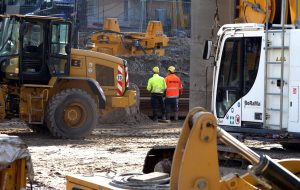
Young unemployed offered training or job opportunities in construction – BCIS chief economist
Dr David Crosthwaite, BCIS – chief economist, said: There is a risk that schemes built around compliance or sanctions place young people into roles that do not align with their skills, interests or longer-term aspirations. For construction, which already faces persistent challenges attracting and retaining new entrants, the priority should be creating conditions that make the sector a positive and deliberate career choice rather than a default option. There is also the practical concern of placing inexperienced young people on potentially dangerous work sites without adequate training. Fundamentally, the industry is suffering from a skills shortage rather than a shortage of general labour, so the focus should be on building capability, not just filling labourer vacancies. At the same time, there could be clear benefits for employers. Many construction firms have stopped replacing workers or paused plans to grow their teams because of cost pressures and uncertainty in the market. If government programmes provide meaningful support with hiring and training costs, this could help firms take on young people they might otherwise be unable to afford to recruit or develop. That could strengthen early-career pipelines at a time when workforce capacity is one of the biggest constraints on delivery. Building, Design & Construction Magazine | The Choice of Industry Professionals

London Set for an Office Revival – If Planning Rules Keep Up
London could be on the brink of a major office construction surge, with developers arguing that the right conditions are finally lining up – provided the planning system becomes more flexible. Fresh analysis from the London Property Alliance and Knight Frank suggests that modernising the capital’s ageing office stock could generate an £84 billion economic uplift and release £262 billion in investment value. Their new report, Space for Change: Office space dynamics in central London, highlights the scale of the challenge: between 2018 and 2023, London’s central activities zone (broadly the area covered by Underground zone 1) lost around 14 million square feet of office space. Over the next five years, the capital is expected to face an 11 million square foot shortfall. Much of the existing stock is no longer fit for purpose. The report notes that 56% of central London offices – around 147 million square feet – are rated as secondary space, offering ageing, lower-quality environments that will fall short of mandatory sustainability requirements by 2030. As a result, upgrading or redeveloping these buildings is becoming increasingly urgent. Vacancy rates for prime space have tightened considerably. Availability of top-tier offices is near historic lows, with just 0.8% of prime and 1.7% of Grade A space currently unoccupied. Only a dozen very large single-floor offices above 40,000 square feet – the sort favoured by major firms consolidating staff – are on the market. Demand from occupiers is strong. Companies are actively searching for 10 million square feet of space, around 7% above the long-term average, propelled chiefly by financial and professional services firms. While 15.4 million square feet of new offices are due to complete between 2025 and 2029, a significant share is already pre-let or situated outside the high-demand areas of the City and West End. This pipeline not only falls short of replacing space lost since 2018, it also fails to meet current or future requirements. Representing central London’s leading developers and investors, the London Property Alliance is calling for a shift in approach, arguing that major office projects should be treated as essential economic infrastructure. They say planning and regulatory processes should be streamlined to improve development viability. Developers report that viability is one of the biggest barriers they face, made worse by a complex and often costly planning framework. They want planning authorities to simplify regulations, reduce obligations and lower the financial burden placed on new schemes. Ross Sayers, chair of the City Property Association and head of development management at Landsec, noted that rising construction, labour and finance costs, combined with growing planning obligations, are putting many projects under pressure. He stressed the need for collaborative, pragmatic solutions to ensure central London remains a world-class business hub. James Raynor, chair of the Westminster Property Association and chief executive of Grosvenor Property, warned that ageing office stock threatens future supply without intervention. He believes that modernising these buildings through flexible, forward-looking planning policies could unlock significant economic growth while supporting net-zero goals and local communities. Shabab Qadar, Knight Frank’s head of central London research and author of the report, described a systemic problem in the office market: demand for high-quality space continues to rise, but supply cannot keep up as buildings are repurposed and planning hurdles restrict redevelopment. He argues that the case for upgrading London’s older office stock has never been stronger. Building, Design & Construction Magazine | The Choice of Industry Professionals

ACO Building Drainage Helps Construction Professionals Tackle Climate Change with Launch of ‘Blue Roof Guide – Volume 2’
With climate extremes increasing and urban drainage networks under growing stress, ACO Building Drainage has published the second volume of its Blue Roof Guide to help architects, engineers, specifiers and contractors design resilient, multi-functional roofscapes. The new guide explains how blue and blue-green roof systems can store and manage rainfall on site, reduce peak flows to overstretched sewers and support passive irrigation and biodiversity on roof areas. The guide, titled ‘ACO Blue Roof Guide – Vol 2’, follows the success of ACO’s first volume of its Blue Roof Guide, launched in October 2024, and builds on the criteria established for safe and sustainable drainage. Sustainability is a core principle of ACO’s work and this has been recognised in the company’s appointment as United Nations ambassador for Sustainable Development Goal 6: Clean Water and Sanitation. The second volume of the Blue Roof Guide is evidence of ACO’s commitment to clean water, sustainability, and supporting the construction industry in creating an eco-friendly future. Volume 2 sets out the principles of off-membrane storage and offers practical design and delivery advice for architects, engineers, specifiers and contractors. It highlights blue roofs as an increasingly important tool in urban developments by storing water temporarily and releasing it slowly to lessen flood risk while enabling green and biosolar roof functions to coexist without compromising waterproofing. Technical sections go into detail about ACO’s patented RoofBloxx system: a shallow, high-strength geocellular attenuation layer designed to sit independently of the roof membrane. Implementation and installation are also discussed, including together with the proper use of flow restrictors, access and diffuser units, capillary wicks and reservoir trays. When combined, these components manage run-off rates, support passive irrigation for sedum and planted systems, and reduce the need for heavy ballast by stabilising insulation. Neill Robinson-Welsh, who has led more than 750 blue roof projects during his 14 years with ACO, said: “Blue roofs are no longer an optional extra but a practical response to the twin pressures of heavier rainfall and growing water stress. Our approach uses ACO RoofBloxx to store water off the waterproofing layer, simplifying integration with green and biosolar elements and reducing the risk of membrane failure. The new guide reflects what we’ve learned on real projects and sets out design and maintenance steps that make blue roofs reliable.” Practical chapters focus on early-stage coordination, addressing outlet positioning, roof slope and structural implications, as well as maintenance-friendly design through permanent access chambers and twice-yearly inspections, and emphasising the importance of accurate hydraulic calculations to meet planning limits while preserving architectural constraints. ACO stresses that designers need to treat blue roofs as system integration exercises, and by coordinating landscape, photovoltaics and other services early it will help to avoid late, costly revisions. Volume 2 is positioned as a hands-on resource for teams planning multifunctional roofs where water management, ecology and service access must all be reconciled. To download the guide, see ACO.co.uk. Building, Design & Construction Magazine | The Choice of Industry Professionals

Scaffolding and Temporary Structures: Safety Checks That Prevent Costly Insurance Claims
Roughly a third of all workplace fatalities in the construction industry stem from falls, with scaffolding-related incidents accounting for a substantial portion. Beyond the human cost, these accidents trigger insurance claims that can reach hundreds of thousands of pounds, often resulting in premium increases that burden businesses for years. Proper safety protocols are more just regulatory compliance — they’re financial protection. The Financial Impact of Scaffolding Failures When scaffolding collapses or workers fall from temporary structures, the immediate costs include emergency response, medical treatment, and work stoppage. However, the long-term financial implications extend far beyond initial expenses. Major incidents typically affect insurance premiums substantially. Industry data suggests that serious claims often lead to premium increases ranging from 30% to 50%, though the exact impact depends on factors including claims history, company size, and specific insurer policies. For small to medium-sized construction firms operating on tight margins, such increases can create serious cash flow challenges. While specialist construction insurers understand these risks, businesses across sectors — from those working with Westminster Insurance on professional liability cover to dedicated construction underwriters — face similar scrutiny of their safety procedures during policy renewals. Pre-Installation Verification Requirements Before any scaffolding goes up, specific checks must occur to prevent structural failures. Ground conditions require assessment by a competent person, with particular attention to load-bearing capacity and drainage patterns that might compromise stability over time. Underground services must be located and marked, as striking gas or electrical lines during foundation installation creates liability exposure beyond standard construction risks. The scaffolding design itself needs formal documentation for certain configurations. Under the Work at Height Regulations 2005, scaffolds must be designed by a competent person where their complexity, height, loading, or configuration exceeds what can be safely erected using recognised standard configurations (such as those in TG20:13 guidance). These documents serve dual purposes: they guide safe erection and provide evidence of due diligence should incidents occur. Daily and Weekly Inspection Protocols Regular inspections form the backbone of claim prevention. The Work at Height Regulations 2005 mandate inspections at specific intervals: These inspections require documentation in an inspection register, recording the date, inspector’s name, identified issues, and corrective actions taken. Inadequate or missing records create significant difficulties when defending claims. Critical Component Checks Certain scaffolding elements demand particular attention during inspections because their failure typically results in the most serious incidents. Base plates and sole boards distribute loads to the ground and must remain level, fully engaged, and free from settlement. Standards (vertical tubes) require checking for plumbness, damage, and proper splicing where joints occur. Ledgers and transoms connecting standards need secure fitting with all clips properly tightened. Platforms must be fully boarded according to the scaffold system’s specifications, properly supported, and equipped with appropriate edge protection at any location where falls exceed 2m. For standard scaffold boards in typical configurations, 150mm overhang (4x thickness for 38mm boards) and supports should be placed at intervals appropriate to the board rating, commonly around 1.5m, though specific systems may vary. Tie patterns securing scaffolding to structures deserve particular scrutiny. These connections prevent toppling and must be installed according to design specifications. Inadequate or damaged ties are one of the most common factors in scaffolding collapse claims. Weather-Related Precautions British weather patterns create specific risks for temporary structures. Wind loading affects scaffolds differently based on height, sheeting coverage, and tie strength. Many manufacturers and guidance documents recommend ceasing work when wind speeds approach or exceed 23 mph, though specific thresholds depend on scaffold configuration, sheeting levels, and loading conditions. Training and Competency Documentation Claims investigations commonly examine whether workers held appropriate cards and whether refresher training was current at the time of the incidents. Companies should maintain training matrices showing qualification dates, renewal schedules, and specific competencies for each scaffolder and supervisor. This documentation demonstrates a systematic approach to competency management and supports the defence position when incidents do occur. Record Keeping That Protects Your Position Detailed records play a valuable role in managing insurance claims effectively. Photograph scaffolds at key stages: foundation preparation, after erection, during use, and post-incident if problems arise. Inspection registers should contain specific observations rather than generic statements. When claims arise months or years after incidents, detailed contemporaneous records carry considerably more weight than reconstructed accounts. The investment in rigorous safety protocols and documentation typically represents good value when measured against the costs associated with serious claims.

5 Critical First Steps to Build a Construction Business
When you want to build a construction business, the steps are similar to those of any other type of company. Of course, there are details that need to be changed, but the first steps are a foundation for any type of company, from market research to securing the funds you need. Registering a Formal Business Business registration is often the first step to being formally recognised. It also places you on the official register for paying taxes and accessing any benefits that come with it. When you register a company with Companies House (UK), for example, it makes the business an entity. However, that means you must also become compliant. So make sure you choose the proper business structure, such as LLC, obtain the licences you need and acquire relevant insurance. Market Research and Niche Definition One of the most overlooked parts of starting a new business is market research. It’s great to have an idea, but that idea might not align with what customers want, so securing business becomes a challenge. Identifying a need and filling it is a major advantage, such as paving services. However, a niche can help your business surpass some competitors by capitalising on a specific need. For example, installing concrete garage floors with an epoxy resin coating. Build a Construction Business with a Plan It is widely believed that over 90% of new businesses fail within the first year. One of the most common reasons for failure is cited as not having an adequate business plan. Of course,operating a successful construction business depends on much more than a plan, but a plan will ensure you build a solid foundation and get off to the best possible start. It helps to include the structure and management team, the services you will offer and detailed financial projections. Securing the Necessary Funding Of course, any business needs funding to start. In construction, new companies typically have a very high startup cost. This is because you need funds for labour, materials and equipment, many of which can be very expensive. As part of your plan, identify accurate costs you can show a lender, like a bank or an investor. You can also secure funding by showing anyone involved accurate projections and the expected time before making a profit for repayment. Finding and Building the Right Team No reliable business operates on luck and prayers. When it comes to something as complex as construction, the right team is critical. Hiring skilled workers who are trained, competent and know what they are doing is an essential first step. However, you will also need to network with suppliers for favourable deals and terms. However, a new business needs to build a solid reputation too. In construction, necessary safety and training, such as OSHA, is an advantage. Summary Registering your company is one of the most important first steps to building a construction business. Of course, a detailed plan will help you get off to a good start. However, any business also relies upon a well-trained, competent and dedicated team when getting off the ground.

How Web3 Finance Tools Could Reshape Construction Capital Flows
Construction is one industry that has never lacked ambition, but its financial systems often struggle to keep up. It’s common for money to move through lenders, consultants, insurers, and project managers. Weeks have passed by the time funds reach suppliers or contractors. This lag creates tension on-site and pressure in the office. Smaller firms feel it most, especially when they are expected to front labour and materials. It’s this financial environment that has led to Web3 finance tools being discussed less as an experiment and more as a response to problems the industry already knows too well. What Other Industries Already Do Well It’s understandable for construction firms to be skeptical about blockchain finance. After all, the sector is well-known for being cautious (and for good reasons). Yet, similar tools are already doing heavy lifting in other industries. Global logistics firms use blockchain systems to manage complex payment chains across borders. Energy markets rely on them to settle frequent, high-value trades between multiple parties. Online casinos offer a clear example of blockchain working at speed. Many of these platforms handle frequent deposits, withdrawals, bonuses, and payouts across diverse cryptocurrencies, and players expect everything to clear quickly and accurately. As a result, decentralised wallets and near-instant crypto payments sit at the core of how these platforms move money every day as essential systems (source:https://casinobeats.com/uk/online-casinos/bitcoin-casinos/). In all of these sectors, systems operate under pressure, where errors cost money and trust. That track record matters when considering whether the technology can hold up in construction. Tokenised Funding and Earlier Access to Capital Tokenised funding offers a different way to raise money for construction projects. Instead of relying solely on banks or private lenders, developers can issue digital tokens linked to future income or ownership rights. This allows investment to come from a broader base and at an earlier stage. For contractors, that matters. Payments can be structured around delivery points rather than delayed approvals. Investors also gain flexibility, as tokens can be held or transferred depending on appetite for risk. The appeal here is not novelty. It is timing, visibility, and a funding structure that better reflects how projects actually progress. Smart Contracts on Live Projects Smart contracts are often described in technical terms, but their impact in construction is straightforward. They release money when agreed conditions are met. A completed inspection, signed delivery note, or verified milestone can trigger payment without further chasing. This reduces disputes and cuts out long approval chains. Subcontractors are paid sooner, which helps with staffing and supplier relationships. Project owners retain control, since funds only move when conditions are satisfied. There are legal details to address, but on active projects, the benefit is less paperwork, minimised errors, less administrative costs, and fewer arguments about when money should move. New Approaches to Credit and Lending Credit remains a sticking point across the construction industry. Many capable firms struggle to access finance because traditional assessments fail to reflect how construction work is delivered. Web3 lending platforms use on-chain records such as verified contracts, performance history, and tokenised assets to assess risk. Borrowing terms can change as a project develops rather than being fixed at the start. This does not remove risk, but it makes it more visible to both sides. For smaller contractors in particular, it offers an option beyond long waits and inflexible terms. Shared Decision Making Through Decentralised Structures Decentralised investment groups also introduce a different way to manage funding decisions. Through blockchain-based governance, multiple stakeholders can contribute capital and vote on how it is allocated. In construction, this use of blockchain could suit regeneration schemes or developments with mixed public and private interests. Voting records and spending decisions remain open to review. That visibility does not guarantee agreement, but it does reduce confusion about who approved what. For projects that rely on collaboration rather than a single dominant funder, this approach deserves attention. Yet, none of this removes the need for caution. UK regulation continues to develop. The Building Safety Act is evidence of this, which is why construction firms must work within existing procurement and financial rules. Integrating new tools with established accounting systems takes time. Conclusion Web3 finance tools are not a cure-all, but they can address daily construction pain points. Slow payments, limited access to capital, and low transparency disrupt sites and supply chains. Tokenised funding, automated payments, and alternative lending can ease those pressures. Adoption will be gradual, but the conversation has moved beyond theory. For an industry that runs on cash flow as much as concrete, that matters.

